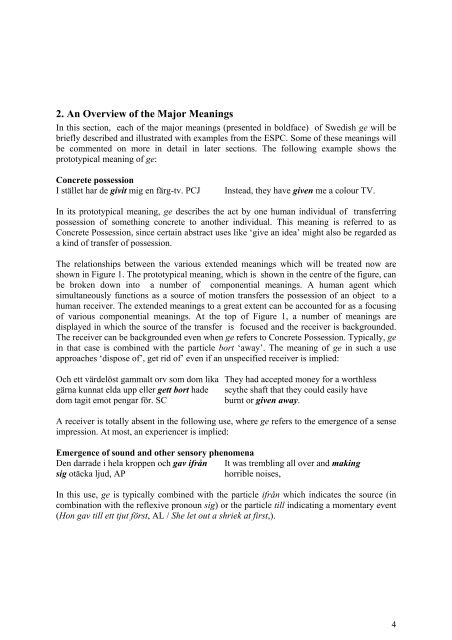The polysemy of Swedish ge 'give'
The polysemy of Swedish ge 'give'
The polysemy of Swedish ge 'give'
You also want an ePaper? Increase the reach of your titles
YUMPU automatically turns print PDFs into web optimized ePapers that Google loves.
2. An Overview <strong>of</strong> the Major Meanings<br />
In this section, each <strong>of</strong> the major meanings (presented in boldface) <strong>of</strong> <strong>Swedish</strong> <strong>ge</strong> will be<br />
briefly described and illustrated with examples from the ESPC. Some <strong>of</strong> these meanings will<br />
be commented on more in detail in later sections. <strong>The</strong> following example shows the<br />
prototypical meaning <strong>of</strong> <strong>ge</strong>:<br />
Concrete possession<br />
I stället har de givit mig en färg-tv. PCJ<br />
Instead, they have given me a colour TV.<br />
In its prototypical meaning, <strong>ge</strong> describes the act by one human individual <strong>of</strong> transferring<br />
possession <strong>of</strong> something concrete to another individual. This meaning is referred to as<br />
Concrete Possession, since certain abstract uses like ‘give an idea’ might also be regarded as<br />
a kind <strong>of</strong> transfer <strong>of</strong> possession.<br />
<strong>The</strong> relationships between the various extended meanings which will be treated now are<br />
shown in Figure 1. <strong>The</strong> prototypical meaning, which is shown in the centre <strong>of</strong> the figure, can<br />
be broken down into a number <strong>of</strong> componential meanings. A human a<strong>ge</strong>nt which<br />
simultaneously functions as a source <strong>of</strong> motion transfers the possession <strong>of</strong> an object to a<br />
human receiver. <strong>The</strong> extended meanings to a great extent can be accounted for as a focusing<br />
<strong>of</strong> various componential meanings. At the top <strong>of</strong> Figure 1, a number <strong>of</strong> meanings are<br />
displayed in which the source <strong>of</strong> the transfer is focused and the receiver is backgrounded.<br />
<strong>The</strong> receiver can be backgrounded even when <strong>ge</strong> refers to Concrete Possession. Typically, <strong>ge</strong><br />
in that case is combined with the particle bort ‘away’. <strong>The</strong> meaning <strong>of</strong> <strong>ge</strong> in such a use<br />
approaches ‘dispose <strong>of</strong>’, <strong>ge</strong>t rid <strong>of</strong>’ even if an unspecified receiver is implied:<br />
Och ett värdelöst gammalt orv som dom lika<br />
gärna kunnat elda upp eller <strong>ge</strong>tt bort hade<br />
dom tagit emot pengar för. SC<br />
<strong>The</strong>y had accepted money for a worthless<br />
scythe shaft that they could easily have<br />
burnt or given away.<br />
A receiver is totally absent in the following use, where <strong>ge</strong> refers to the emer<strong>ge</strong>nce <strong>of</strong> a sense<br />
impression. At most, an experiencer is implied:<br />
Emer<strong>ge</strong>nce <strong>of</strong> sound and other sensory phenomena<br />
Den darrade i hela kroppen och gav ifrån It was trembling all over and making<br />
sig otäcka ljud, AP<br />
horrible noises,<br />
In this use, <strong>ge</strong> is typically combined with the particle ifrån which indicates the source (in<br />
combination with the reflexive pronoun sig) or the particle till indicating a momentary event<br />
(Hon gav till ett tjut först, AL / She let out a shriek at first,).<br />
4
















